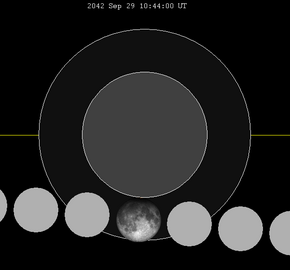| Penumbral eclipse | |||||||||
 The Moon's hourly motion shown right to left The Moon's hourly motion shown right to left | |||||||||
| Date | September 29, 2042 | ||||||||
|---|---|---|---|---|---|---|---|---|---|
| Gamma | −1.0261 | ||||||||
| Magnitude | −0.0011 | ||||||||
| Saros cycle | 118 (53 of 73) | ||||||||
| Penumbral | 238 minutes, 32 seconds | ||||||||
| |||||||||
| ← April 2042October 2042 → | |||||||||
A penumbral lunar eclipse will occur at the Moon’s ascending node of orbit on Monday, September 29, 2042, with an umbral magnitude of −0.0011. A lunar eclipse occurs when the Moon moves into the Earth's shadow, causing the Moon to be darkened. A penumbral lunar eclipse occurs when part or all of the Moon's near side passes into the Earth's penumbra. Unlike a solar eclipse, which can only be viewed from a relatively small area of the world, a lunar eclipse may be viewed from anywhere on the night side of Earth. Occurring only about 9 hours before perigee (on September 29, 2042, at 19:45 UTC), the Moon's apparent diameter will be larger.
Earlier sources compute this as a 0.3% partial eclipse lasting under 12 minutes, but newer calculations list it as a penumbral eclipse that never enters the umbral shadow.
Visibility
The eclipse will be completely visible over eastern Australia, northeast Asia, and western North America, seen rising over east Asia and western Australia and setting over eastern North America and South America.
 
|
Eclipse details
Shown below is a table displaying details about this particular solar eclipse. It describes various parameters pertaining to this eclipse.
| Parameter | Value |
|---|---|
| Penumbral Magnitude | 0.95481 |
| Umbral Magnitude | −0.00105 |
| Gamma | −1.02617 |
| Sun Right Ascension | 12h23m37.3s |
| Sun Declination | -02°33'13.4" |
| Sun Semi-Diameter | 15'57.9" |
| Sun Equatorial Horizontal Parallax | 08.8" |
| Moon Right Ascension | 00h25m38.7s |
| Moon Declination | +01°38'07.3" |
| Moon Semi-Diameter | 16'42.1" |
| Moon Equatorial Horizontal Parallax | 1°01'18.0" |
| ΔT | 80.7 s |
Eclipse season
See also: Eclipse cycleThis eclipse is part of an eclipse season, a period, roughly every six months, when eclipses occur. Only two (or occasionally three) eclipse seasons occur each year, and each season lasts about 35 days and repeats just short of six months (173 days) later; thus two full eclipse seasons always occur each year. Either two or three eclipses happen each eclipse season. In the sequence below, each eclipse is separated by a fortnight. The first and last eclipse in this sequence is separated by one synodic month.
| September 29 Ascending node (full moon) |
October 14 Descending node (new moon) |
October 28 Ascending node (full moon) |
|---|---|---|
 |
 |

|
| Penumbral lunar eclipse Lunar Saros 118 |
Annular solar eclipse Solar Saros 144 |
Penumbral lunar eclipse Lunar Saros 156 |
Related eclipses
Eclipses in 2042
- A penumbral lunar eclipse on April 5.
- A total solar eclipse on April 20.
- A penumbral lunar eclipse on September 29.
- An annular solar eclipse on October 14.
- A penumbral lunar eclipse on October 28.
Metonic
- Preceded by: Lunar eclipse of December 11, 2038
- Followed by: Lunar eclipse of July 18, 2046
Tzolkinex
- Preceded by: Lunar eclipse of August 19, 2035
- Followed by: Lunar eclipse of November 9, 2049
Half-Saros
- Preceded by: Solar eclipse of September 23, 2033
- Followed by: Solar eclipse of October 4, 2051
Tritos
- Preceded by: Lunar eclipse of October 30, 2031
- Followed by: Lunar eclipse of August 29, 2053
Lunar Saros 118
- Preceded by: Lunar eclipse of September 18, 2024
- Followed by: Lunar eclipse of October 9, 2060
Inex
- Preceded by: Lunar eclipse of October 18, 2013
- Followed by: Lunar eclipse of September 9, 2071
Triad
- Preceded by: Lunar eclipse of November 29, 1955
- Followed by: Lunar eclipse of July 31, 2129
Lunar eclipses of 2042–2045
| Descending node | Ascending node | |||||
|---|---|---|---|---|---|---|
| Saros | Date Viewing |
Type Chart |
Saros | Date Viewing |
Type Chart | |
| 113 | 2042 Apr 05
|
Penumbral
|
118 | 2042 Sep 29
|
Penumbral
| |
| 123 | 2043 Mar 25
|
Total
|
128 | 2043 Sep 19
|
Total
| |
| 133 | 2044 Mar 13
|
Total
|
138 | 2044 Sep 07
|
Total
| |
| 143 | 2045 Mar 03
|
Penumbral
|
148 | 2045 Aug 27
|
Penumbral
| |
| Last set | 2041 May 16 | Last set | 2042 Nov 08 | |||
| Next set | 2046 Jan 22 | Next set | 2046 Jul 18 | |||
Half-Saros cycle
A lunar eclipse will be preceded and followed by solar eclipses by 9 years and 5.5 days (a half saros). This lunar eclipse is related to two annular solar eclipses of Solar Saros 125.
| September 23, 2033 | October 4, 2051 |
|---|---|

|

|
See also
References
- "September 28–29, 2042 Penumbral Lunar Eclipse". timeanddate. Retrieved 3 December 2024.
- "Moon Distances for London, United Kingdom, England". timeanddate. Retrieved 3 December 2024.
- "Extremes of Lunar Eclipse from 1900 to 2100". www.hko.gov.hk.
- "Penumbral Lunar Eclipse of 2042 Sep 29" (PDF). NASA. Retrieved 3 December 2024.
- "Penumbral Lunar Eclipse of 2042 Sep 29". EclipseWise.com. Retrieved 3 December 2024.
- Mathematical Astronomy Morsels, Jean Meeus, p.110, Chapter 18, The half-saros
External links
- 2042 Sep 29 chart: Eclipse Predictions by Fred Espenak, NASA/GSFC
This lunar eclipse-related article is a stub. You can help Misplaced Pages by expanding it. |


